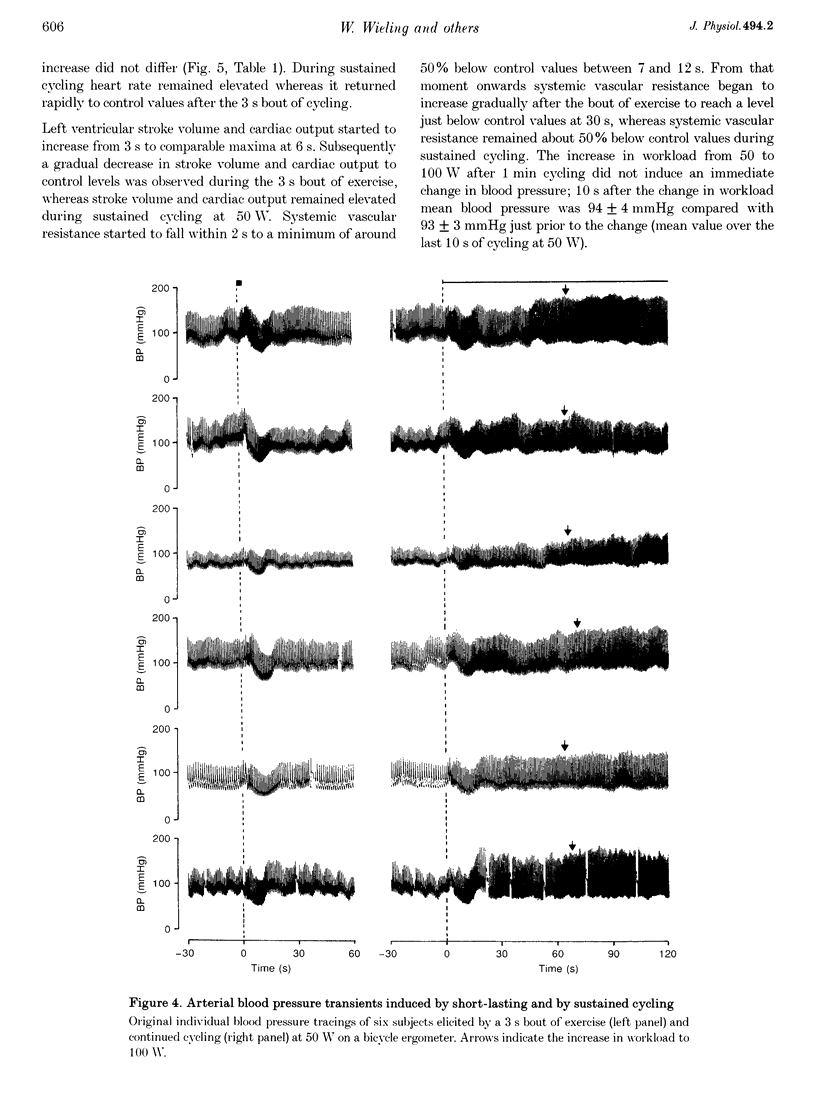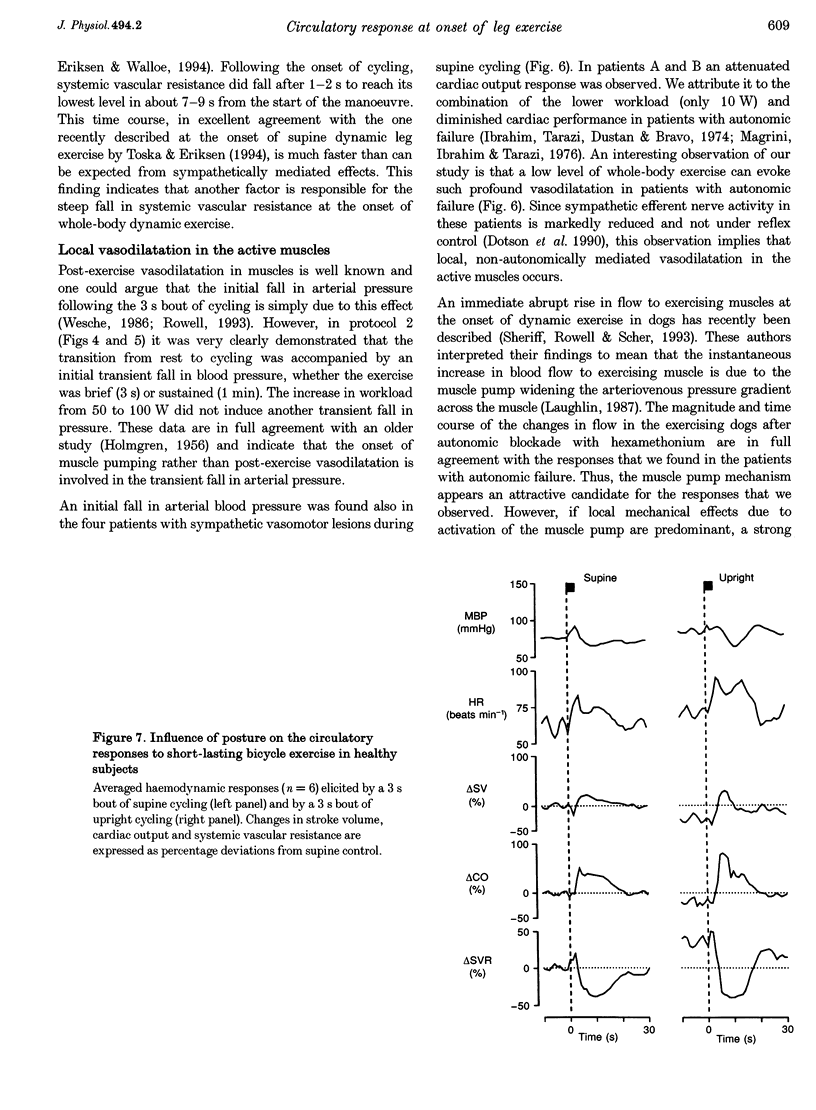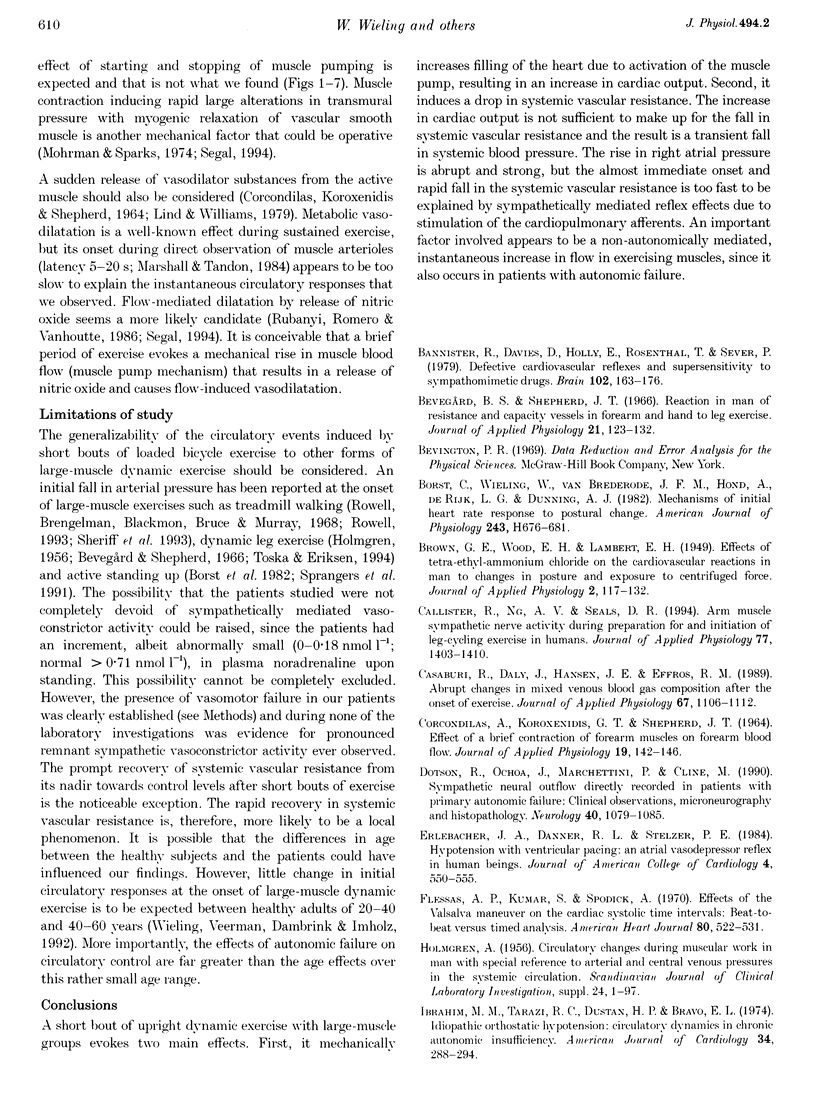Abstract
1. The mechanisms underlying the pronounced transient fall in arterial blood pressure evoked by a 3 s bout of bicycle exercise were investigated in twenty healthy young adults and four patients with hypoadrenergic orthostatic hypotension. 2. In healthy subjects a 3 s bout of upright cycling induced a 28 +/- 3 mmHg fall in mean arterial pressure at 12 s. The fall in mean arterial pressure was preceded by a 12 +/- 2 mmHg rise in right atrial pressure at 3 s and accompanied by a 54 +/- 7% increase in left ventricle stroke volume at 6 s. Systemic vascular resistance dropped 48 +/- 2% at 7 s after the start of the manoeuvre to remain at that level for approximately 5 s. The total response lasted about 20 s. During sustained upright cycling the initial fall in mean arterial pressure was also present, but less pronounced (17 +/- 2 vs. 26 +/- 3 mmHg). A 3 s bout of supine cycling in four patients with hypoadrenergic orthostatic hypotension also elicited a pronounced fall in mean arterial pressure (22 +/- 4 mmHg) and in systemic vascular resistance (38 +/- 4%). 3. A bout of exercise with a large muscle mass induces two main effects. First, it mechanically increases filling of the heart due to activation of the muscle pump, resulting in an increase in cardiac output. Second, it induces a drop in systemic vascular resistance. The increase in cardiac output is not sufficient to compensate fully for the pronounced fall in systemic vascular resistance and the result is a transient fall in arterial pressure at the onset of whole-body exercise. The rise in right atrial pressure evoked by 3 s cycling is abrupt and large, but the almost immediate onset and rapid fall of the systemic vascular resistance is too fast for sympathetically mediated reflex effects due to stimulation of the cardiopulmonary afferents. An important factor involved in the drop in systemic vascular resistance appears to be local, non-autonomically mediated vasodilatation in exercising muscles, since it also occurs in patients with autonomic failure.
Full text
PDF










Selected References
These references are in PubMed. This may not be the complete list of references from this article.
- Bannister R., Davies B., Holly E., Rosenthal T., Sever P. Defective cardiovascular reflexes and supersensitivity to sympathomimetic drugs in autonomic failure. Brain. 1979 Mar;102(1):163–176. doi: 10.1093/brain/102.1.163. [DOI] [PubMed] [Google Scholar]
- Bevegård B. S., Shepherd J. T. Reaction in man of resistance and capacity vessels in forearm and hand to leg exercise. J Appl Physiol. 1966 Jan;21(1):123–132. doi: 10.1152/jappl.1966.21.1.123. [DOI] [PubMed] [Google Scholar]
- Borst C., Wieling W., van Brederode J. F., Hond A., de Rijk L. G., Dunning A. J. Mechanisms of initial heart rate response to postural change. Am J Physiol. 1982 Nov;243(5):H676–H681. doi: 10.1152/ajpheart.1982.243.5.H676. [DOI] [PubMed] [Google Scholar]
- CORCONDILAS A., KOROXENIDIS G. T., SHEPHERD J. T. EFFECT OF A BRIEF CONTRACTION OF FOREARM MUSCLES ON FOREARM BLOOD FLOW. J Appl Physiol. 1964 Jan;19:142–146. doi: 10.1152/jappl.1964.19.1.142. [DOI] [PubMed] [Google Scholar]
- Callister R., Ng A. V., Seals D. R. Arm muscle sympathetic nerve activity during preparation for and initiation of leg-cycling exercise in humans. J Appl Physiol (1985) 1994 Sep;77(3):1403–1410. doi: 10.1152/jappl.1994.77.3.1403. [DOI] [PubMed] [Google Scholar]
- Casaburi R., Daly J., Hansen J. E., Effros R. M. Abrupt changes in mixed venous blood gas composition after the onset of exercise. J Appl Physiol (1985) 1989 Sep;67(3):1106–1112. doi: 10.1152/jappl.1989.67.3.1106. [DOI] [PubMed] [Google Scholar]
- Dotson R., Ochoa J., Marchettini P., Cline M. Sympathetic neural outflow directly recorded in patients with primary autonomic failure: clinical observations, microneurography, and histopathology. Neurology. 1990 Jul;40(7):1079–1085. doi: 10.1212/wnl.40.7.1079. [DOI] [PubMed] [Google Scholar]
- Erlebacher J. A., Danner R. L., Stelzer P. E. Hypotension with ventricular pacing: an atria vasodepressor reflex in human beings. J Am Coll Cardiol. 1984 Sep;4(3):550–555. doi: 10.1016/s0735-1097(84)80100-x. [DOI] [PubMed] [Google Scholar]
- Flessas A. P., Kumar S., Spodick D. H. Effects of the Valsalva maneuver on the cardiac systolic intervals: beat-to-beat versus timed analysis. Am Heart J. 1970 Oct;80(4):522–531. doi: 10.1016/0002-8703(70)90201-2. [DOI] [PubMed] [Google Scholar]
- Imholz B. P., van Montfrans G. A., Settels J. J., van der Hoeven G. M., Karemaker J. M., Wieling W. Continuous non-invasive blood pressure monitoring: reliability of Finapres device during the Valsalva manoeuvre. Cardiovasc Res. 1988 Jun;22(6):390–397. doi: 10.1093/cvr/22.6.390. [DOI] [PubMed] [Google Scholar]
- Jansen J. R., Wesseling K. H., Settels J. J., Schreuder J. J. Continuous cardiac output monitoring by pulse contour during cardiac surgery. Eur Heart J. 1990 Dec;11 (Suppl 1):26–32. doi: 10.1093/eurheartj/11.suppl_i.26. [DOI] [PubMed] [Google Scholar]
- Lind A. R., Williams C. A. The control of blood flow through human forearm muscles following brief isometric contractions. J Physiol. 1979 Mar;288:529–547. [PMC free article] [PubMed] [Google Scholar]
- Magrini F., Ibrahim M. M., Tarazi R. C. Abnormalities of supine hemodynamics in idiopathic orthostatic hypotension. Cardiology. 1976;61 Suppl 1:125–135. doi: 10.1159/000169804. [DOI] [PubMed] [Google Scholar]
- Marshall J. M., Tandon H. C. Direct observations of muscle arterioles and venules following contraction of skeletal muscle fibres in the rat. J Physiol. 1984 May;350:447–459. doi: 10.1113/jphysiol.1984.sp015211. [DOI] [PMC free article] [PubMed] [Google Scholar]
- Mohrman D. E., Sparks H. V. Myogenic hyperemia following brief tetanus of canine skeletal muscle. Am J Physiol. 1974 Sep;227(3):531–535. doi: 10.1152/ajplegacy.1974.227.3.531. [DOI] [PubMed] [Google Scholar]
- O'Brien P. C., Shampo M. A. Statistical considerations for performing multiple tests in a single experiment. 3. Repeated measures over time. Mayo Clin Proc. 1988 Sep;63(9):918–920. doi: 10.1016/s0025-6196(12)62696-2. [DOI] [PubMed] [Google Scholar]
- RODDIE I. C., SHEPHERD J. T., WHELAN R. F. Reflex changes in vasoconstrictor tone in human skeletal muscle in response to stimulation of receptors in a low-pressure area of the intrathoracic vascular bed. J Physiol. 1957 Dec 31;139(3):369–376. doi: 10.1113/jphysiol.1957.sp005897. [DOI] [PMC free article] [PubMed] [Google Scholar]
- Rowell L. B., Brengelmann G. L., Blackmon J. R., Bruce R. A., Murray J. A. Disparities between aortic and peripheral pulse pressures induced by upright exercise and vasomotor changes in man. Circulation. 1968 Jun;37(6):954–964. doi: 10.1161/01.cir.37.6.954. [DOI] [PubMed] [Google Scholar]
- Sheriff D. D., Rowell L. B., Scher A. M. Is rapid rise in vascular conductance at onset of dynamic exercise due to muscle pump? Am J Physiol. 1993 Oct;265(4 Pt 2):H1227–H1234. doi: 10.1152/ajpheart.1993.265.4.H1227. [DOI] [PubMed] [Google Scholar]
- Stok W. J., Baisch F., Hillebrecht A., Schulz H., Meyer M., Karemaker J. M. Noninvasive cardiac output measurement by arterial pulse analysis compared with inert gas rebreathing. J Appl Physiol (1985) 1993 Jun;74(6):2687–2693. doi: 10.1152/jappl.1993.74.6.2687. [DOI] [PubMed] [Google Scholar]
- Taylor J. A., Joyner M. J., Chase P. B., Seals D. R. Differential control of forearm and calf vascular resistance during one-leg exercise. J Appl Physiol (1985) 1989 Nov;67(5):1791–1800. doi: 10.1152/jappl.1989.67.5.1791. [DOI] [PubMed] [Google Scholar]
- Toska K., Eriksen M., Walløe L. Short-term cardiovascular responses to a step decrease in peripheral conductance in humans. Am J Physiol. 1994 Jan;266(1 Pt 2):H199–H211. doi: 10.1152/ajpheart.1994.266.1.H199. [DOI] [PubMed] [Google Scholar]
- Vissing S. F., Scherrer U., Victor R. G. Relation between sympathetic outflow and vascular resistance in the calf during perturbations in central venous pressure. Evidence for cardiopulmonary afferent regulation of calf vascular resistance in humans. Circ Res. 1989 Dec;65(6):1710–1717. doi: 10.1161/01.res.65.6.1710. [DOI] [PubMed] [Google Scholar]
- Wieling W., ten Harkel A. D., van Lieshout J. J. Spectrum of orthostatic disorders: classification based on an analysis of the short-term circulatory response upon standing. Clin Sci (Lond) 1991 Aug;81(2):241–248. doi: 10.1042/cs0810241. [DOI] [PubMed] [Google Scholar]


